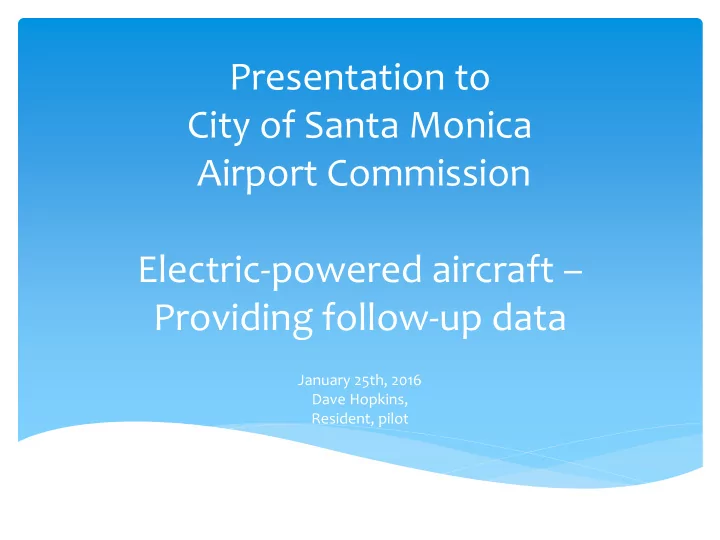

Presentation to City of Santa Monica Airport Commission Electric-powered aircraft – Providing follow-up data January 25th, 2016 Dave Hopkins, Resident, pilot
Contents This presentation of data is in follow-up to electric- powered aircraft presentation to airport commission on November 23, 2015. Commissioners asked general questions on following subjects: 1. Availability of electric aircraft and from whom? 2. FAA certification process and availability? 3. Range and charging time? 4. Special training for electric aircraft? 5. Runway length required for operations? Summary answers following. Detailed data in Appendix
Electric-powered aircraft Questions # 1. Availability and from whom? Three main contenders, plus host of start- up’s and experimental aircraft. Airbus subsidiary VoltAir . 2 and 4 seat versions planned for FAA certification 2018 and 2019 respectively. Named E-fan 2.0 and E-fan 4.0. Manufactured in France. Bye Aerospace. Sunflyer. US company. Denver-based. two-seat prototype flying. Noise measurements indicate 30+ db aircraft noise reduction over typical, comparable light aircraft. Estimated costs, $1.0 per hour of electricity, versus approx $24.0 for gasoline. Pipistrel. Alpha electro two-seat model. Flying now, certified in Europe. Range approx 1 hour with 30 mins reserve. Based Slovenia. Take-off and landing distance, less than 1,000 feet. Notable start-ups and emerging companies. China-based Yuneec International. Elektra One, Germany based. Sonex, US aircraft kit manufacturer.
FAA certification and availability Question # 2. FAA certification and availability? 1. FAA working with various manufacturers. 2. Expected FAA certification process to start in 2016 with Airbus leading with its VoltAi r E-Fan 2.0. Airbus advertise 2018 FAA certification target for 2.0 and 2019 for 4.0 3. FAA Light Sport Category of aircraft includes only “reciprocating engines” definition. Expected to be modified to include “electric engines.” 4. Electric engines and batteries offer substantially reduced failure rates and failure modes, parts count, moving parts and routine maintenance. Significant safety benefits.
Range and charging time Question # 3. Range and charging time? 1. Range? A . No FAA certified numbers available. B. Airbus indicates 1.5 hours for typical training mission. C. Pipistrel indicates 1.5 hours for typical training mission. D. Electric aircraft will have to equal or exceed current gasoline- powered trainers to gain market acceptance. E. English Channel (approx. 22 miles) crossed in electric aircraft July 9, 2015 2. Charging time? Similar to electric autos. For 18 Kw battery A. 110 volts – 10 hours – using any household/office outlet B. 220 volts – 2-3 hours - same as 55+ public electric auto charging stations in Santa Monica and at SMO C. 480 volts – 30 min or less. Same as Nissan, Tesla, chargers D. Battery swap, where applicable, 3-5 minutes
FAA Training Required? Question #4 Special training for electric aircraft? 1. No FAA regulations at this time. FAA already has “differences training” established for following categories of aircraft. Starting from Private Pilot Certificate (PPC) for Single-Engine Land (SEL) Aircraft. (Typical flight training times) A. High Performance, 200+ horse-power engine (2-5 hours) B. Complex , complex aircraft systems (3-6 hours) C. Single-Engine Sea (5-10 hours) D. Multi-Engine, Land (5-10 hours) E. Sailplanes or gliders (10-15 hours)
Runway length required for operations? Question #5 Runway length required for operations? 2 & 4 seat versions? 1. No FAA certified data available . 2. Pipistrel, under European EASA regulations (EASA is European version of FAA). Indicate under 1,000 feet required for take-off and landing. 3. Bye Aerospace and Airbus. No data available Jan 2016. Expected to be equal or better to current gasoline- powered trainers. 4. Runway required and Community Noise. Less runway required, generally indicates higher climb performance, thus electric-powered aircraft should generate substantially less community noise perceived on ground.
Appendix - Supporting data
About the author. Dave Hopkins is a seventeen-year resident of Santa Monica, business owner and pilot. An air transport industry professional, he has worked for several manufacturers, including, Airbus, Boeing, Rolls-Royce and several air carriers, including Santa Monica’s Surf Air. He is now Executive Chairman of Air Transport Business Development, Inc. a Santa Monica business serving the air transport industry. Dave has held an active and current FAA pilot certificate for 34 years and FAA Flight Instructor Certificate for 15 years. He serves his community, in part, as a flight instructor, teaching the next generation of aviators using his 3,400+ hours of flight experience. Dave Holds the following aviation qualifications: MSc. Air Transport Management, Cranfield University, UK FAA Airline Transport Pilot, multi-engine land FAA Commercial Pilot, single-engine land FAA Certified Flight Instructor, with single, multi-engine land and instrument certificates. FAA certificates and endorsements for gliders, seaplanes and tailwheel aircraft.
Recommend
More recommend